
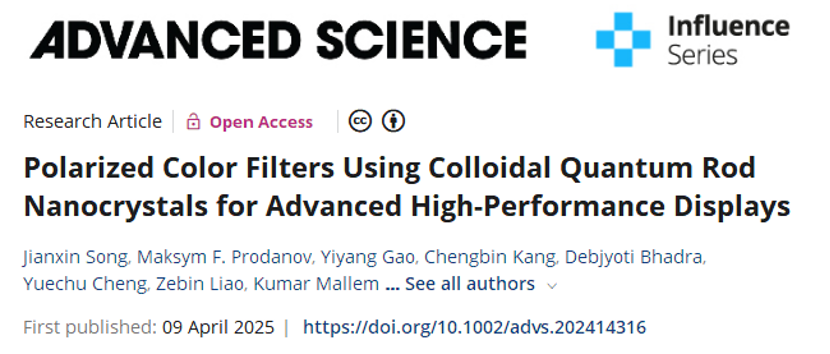
▲ First Author: Jianxin Song
Advisor: Abhishek K. Srivastava
Corresponding Institution: Hong Kong University of Science and Technology, State Key Laboratory of Advanced Display and Optoelectronic Technologies (SKL)
Paper DOI: 10.1002/advs.202414316 (Click “Read the original text” at the end for direct link)
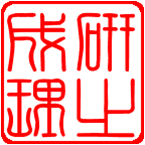 Background Introduction
Background Introduction
This paper presents a color filter that emits linearly polarized light, achieving full color and pixel-level precision while providing modern displays with high color saturation, high ambient contrast, and high efficiency. The narrowband polarized emission of quantum rods (QRs) effectively alleviates the challenges of traditional color purity and light loss. By utilizing specially designed ligands on the surface of the quantum rods, we achieved high loading and uniform orientation of the quantum rod material in a polymer matrix. Through the optimization of inkjet printing, photolithography, and optical alignment processes, we achieved a significant degree of polarization (DOP 0.65. Due to the polarized emission characteristics of unidirectionally aligned quantum rods, liquid crystal displays equipped with thisQRCF exhibit higher efficiency and ambient contrast, highlighting their advantages in next-generation display applications.
 Research Motivation
Research Motivation
Full-color display technology has undergone dynamic and multifaceted evolution in recent years as a fundamental pillar of visual technology. This technology utilizes color as a medium to transform the complexity and richness of the real world into visual information. Liquid crystal displays (LCD) have become the primary display technology due to their reliability, ease of integration, and aesthetic appearance. Subsequently, organic light-emitting diode (OLED) technology has opened a new chapter in display technology history with its superior contrast and design flexibility. Despite significant improvements in image quality over the past few years, reaching the limits of human vision, the efficiency of these displays remains between 3-5%, which further decreases for high pixel density displays. The Energy Efficiency Index (EEI) is used to measure the power consumption of display products, defined as:Pmeasured is the measured power in the ON mode under normal configuration (calculated in standard dynamic range),corr is a correction factor. The European Union revised the EEI limit for modern displays in ON mode to 0.9 on March 1, 2023. The EEI of commercially available displays ranges from 1.4 to 1.8. One of the key components of display devices (whether LCD or OLED) is the color filter (CF). Due to its absorption properties, it leads to over 70% optical loss, making it difficult to further improve display energy efficiency. Extending battery life requires sacrificing display brightness, image frequency, or other performance aspects.
Traditional LCD backlight emits white light, which is controlled for brightness and final color through a polarizer and then through the liquid crystal unit. The colors in traditional LCD panels are primarily obtained through organic dyes, which absorb light in specific wavelength regions. Each pixel’s three absorptive color filters (ACF, red, green, blue) provide full-color images, but due to the absorption of most initial white light, optical efficiency is reduced. Additionally, due to the wide and heavily overlapping absorption bands of R, G, B, ACF exhibits poor color saturation. Similar issues exist in white OLED using ACF for color reproduction.
Recently, color filters made from photoluminescent materials (PLCF) have garnered increasing attention as they achieve higher brightness, better efficiency, wider viewing angles, and full-color emission types entering the micro LED display field. Replacing ACF with PLCF in LCD and using short wavelengths (blue/ ultraviolet) backlight can improve efficiency and color performance, which has a profound impact on the display industry. LCDs equipped with PLCF exhibit high brightness and a large color gamut.
In contrast, PLCF based on fluorescent organic dyes faces issues such as limited internal quantum efficiency (IQE) due to quenching phenomena caused by aggregation and low color purity due to broad emission spectra. Although some measures have been taken to mitigate these issues, such as molecular chemical modification and encapsulation to suppress aggregation or synthesizing organic quantum dots and utilizing microcavity structures to reduce emission bandwidth, these methods significantly increase the complexity and cost of CF manufacturing. Recently, mini/ micro LED display technology has emerged, marking a significant development in next-generation display technology. With advantages of high resolution, wide color gamut, and low energy consumption, this technology holds unprecedented potential in the evolution of the display industry. Despite these advancements, it still faces severe technical challenges for large-scale transfer and requires different substrates to manufacture LEDs of different wavelengths. As proposed by Samsung, the OLED industry is also moving towards blue OLED equipped with down-conversion quantum dots. Therefore, the preferred solution in the industry is to combine backlight units with nanomaterial color conversion layers. Quantum dots and related semiconductor nanoparticles are being extensively researched for their potential applications in future display technologies. These materials can achieve narrowband photoluminescence through quantum confinement effects. Furthermore, by controlling the size/ composition of quantum dots, the emitted color can be precisely tuned.
 Illustrative Analysis
Illustrative Analysis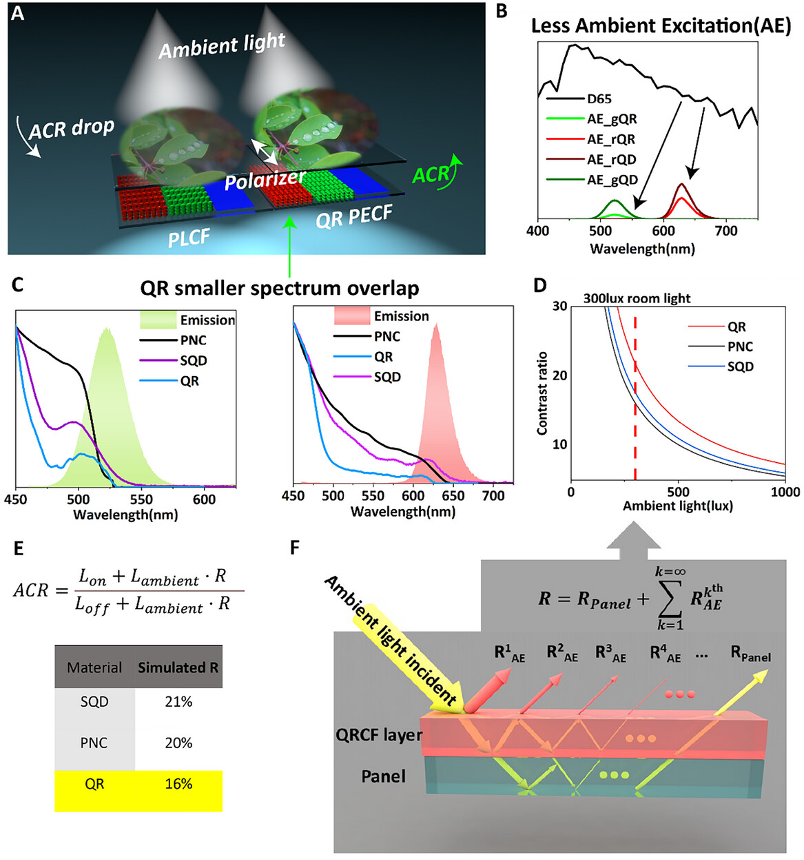
Figure 1: Schematic diagram of the ambient light effect problem causing ACR decrease and examples comparing PECF and PLCF; b) Differences in simulation results of QDCF and QRCF under ambient light excitation; c) Relative overlap of absorption (normalized at 450 nm) and emission spectra of different materials; d) Simulated display images and e ACR, f) Simulated model of ACR calculation and results of the ambient light excitation part.
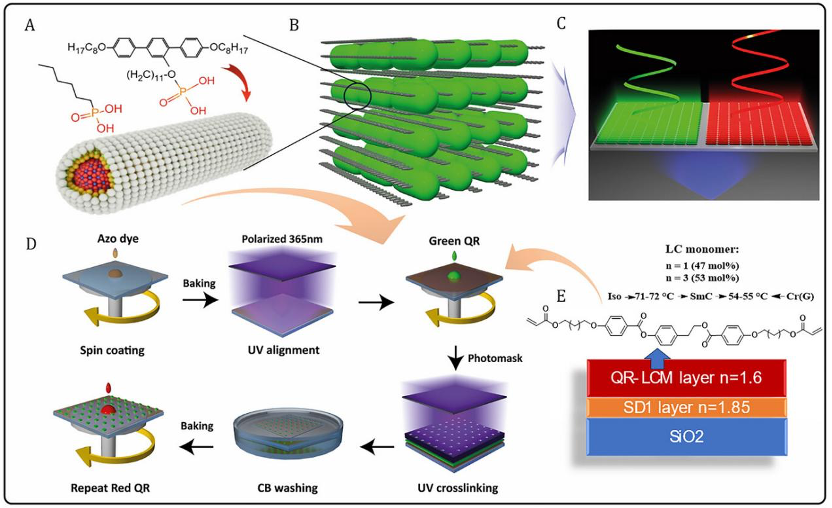
Figure 2: Schematic of quantum rods ( QR) with T-shaped and HPA ligand combinations; a) Schematic of quantum rods ( QR); b) QRS of QRS; c) PLCF with polarized emission; d) PLCF manufacturing process; e) CF layer structure and LCM molecular composition.
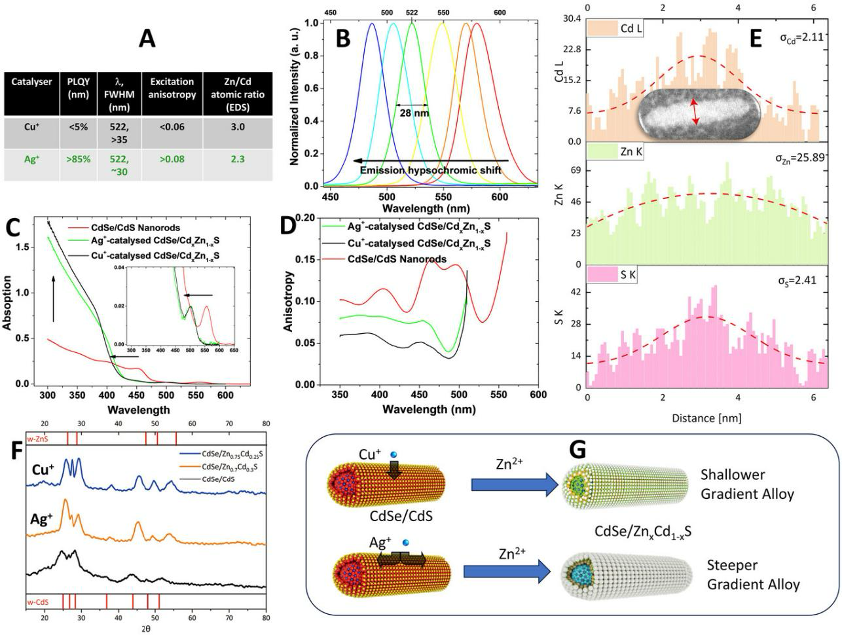
Figure 3: Characterization of PowerPoint QR materials. a) Comparison of performance of CDSE/ZNXCD1-XS QR prepared with Cu+ and Ag+ properties; b) PL emission trends of CDSE/ZNXCD1-XS QRS synthesis; c) Absorption andd) Green emission of CDSE/ZNXCD1-XS QR synthesized with CU+ and AG+ catalyst; e) Radial EDS elemental mapping results of single CDSE/ZNXCD1-XS QR prepared with Ag+ Catalyzer; f) Powder X-ray analysis results of CDSE/ZNXCD1-XS QRS; g) Schematic of cation exchange process from CD2+ to Zn2+ using different catalysts.
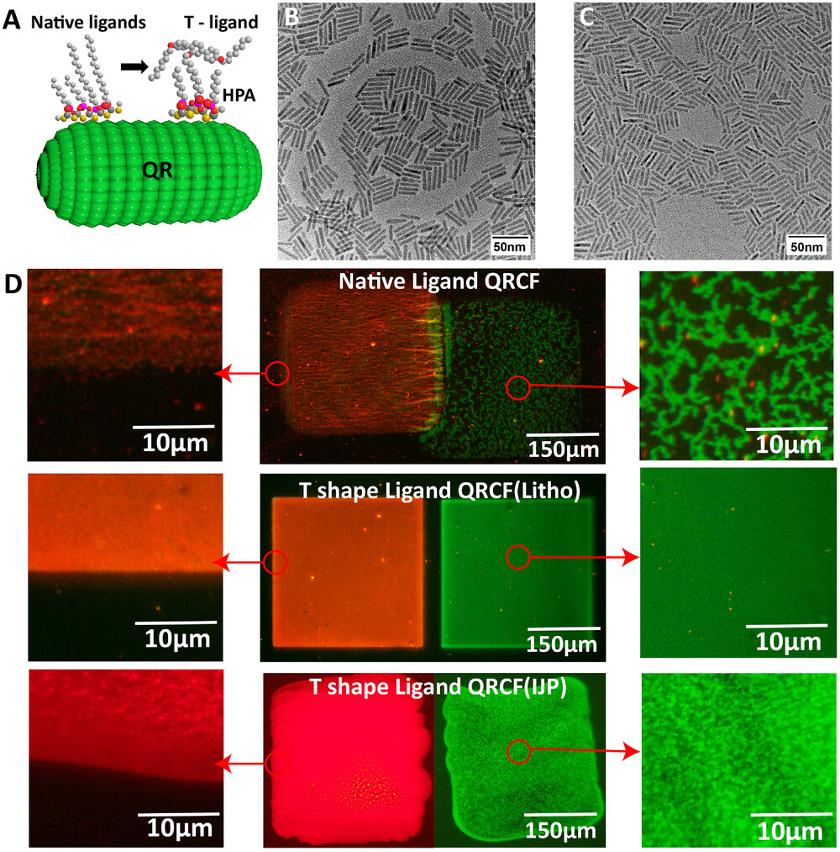
Figure 4: T-shaped ligand exchange of QR. b) Green QR and c) Red QR TEM images.
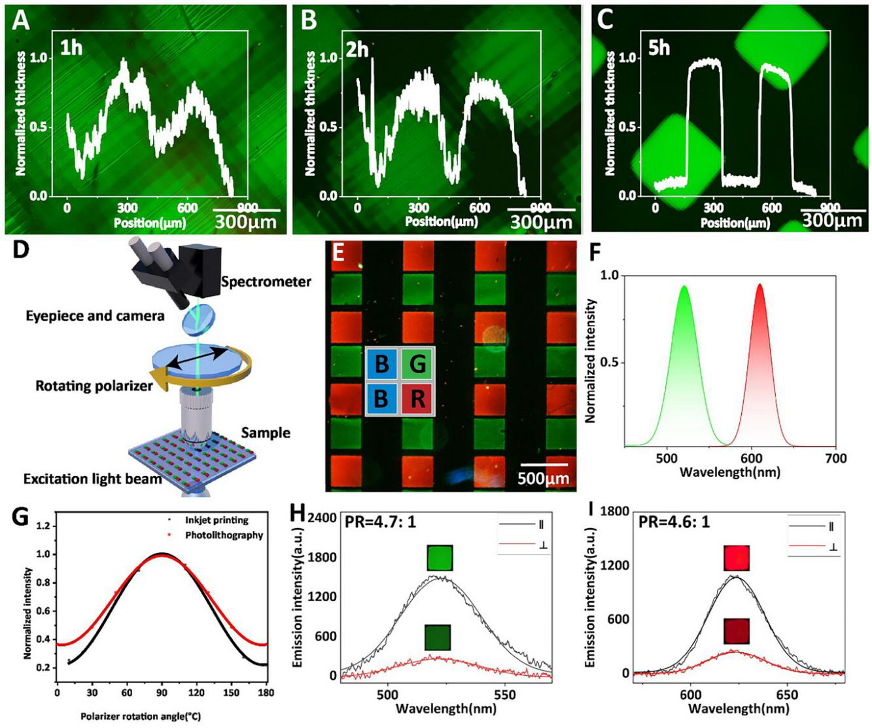
Figure 5: FM images and diagonal brightness distribution curves of PLCF membranes after washing for a) 1 h, b) 2 h, c) 5 h; d) Schematic of DOP measurement of PLCF pixels; e) FM images of GB PLCF arrays; f) PL spectra of green and red PLCF; g) Variation of PL intensity of PLCF with different manufacturing methods of polarizer angles; h) Parallel and vertical polarized layer states of green pl spectrum; and i) Red PECF..
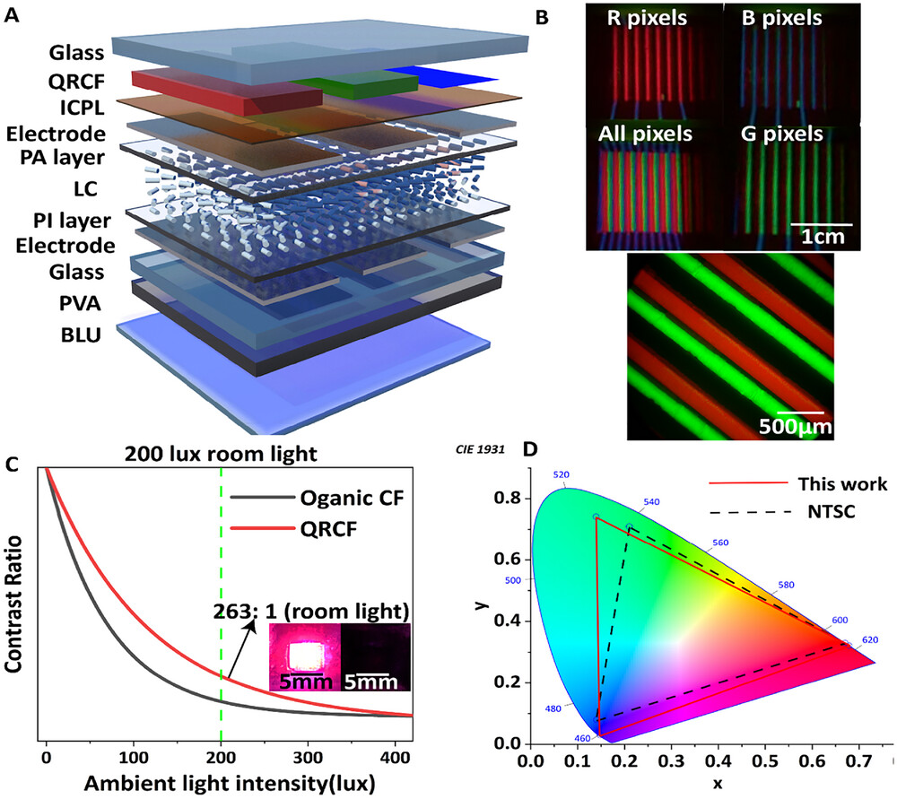
Figure 6: Schematic diagram of PECF PECF full-color LCD devices; b) Micro-images of PECF displays with different pixel on/off states and manufacturing; c) Comparison of ACR between QRCF and organic dye CF; d) Color gamut of CIE1931 color space devices.
 Conclusion and Outlook
Conclusion and Outlook
This study demonstrates the polarized emission color filter technology as a promising alternative to traditional quantum dot displays. Through the synthesis of quantum rods and surface ligand design, combined with inkjet printing and photolithography processes, high polarization and pixel-level precision color filters have been achieved. This technology provides new possibilities for the development of next-generation high-performance displays.
[Original Link]
J. Song, M. F. Prodanov, Y. Gao, C. Kang, D. Bhadra, Y. Cheng, Z. Liao, K. Mallem, V. Swaminathan, V. V. Vashchenko, X. Wu, X. Liu, A. K. Srivastava, Polarized Color Filters Using Colloidal Quantum Rod Nanocrystals for Advanced High-Performance Displays. Adv. Sci. 2025, 2414316.
https://doi.org/10.1002/advs.202414316
 Yunli Cloud Server
Yunli Cloud Server
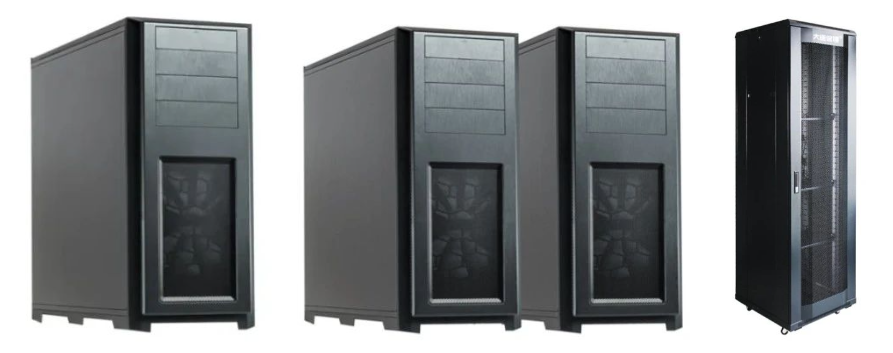
Business Introduction
Yunli Cloud, a provider of high-performance computing solutions specifically for the scientific computing field under the Yanzhi Chengli brand. We offer server hardware sales and cluster system construction and maintenance services.
● Diverse configurations (single tower, dual tower, multiple rack-mounted), customizable, reliable quality, and high cost-performance ratio.
● We have provided server hardware and software services for over 100 research groups nationwide (can provide consultation on past cases from the same or nearby universities). ● Our server application engineers have research backgrounds in quantum chemistry, first principles, molecular dynamics, and other related disciplines. ● The company collaborates with several experts in theoretical calculations in chemistry and materials to explore optimal server hardware and software configurations and deployments. ● Participation in bidding is possible.Product Features ● Customized hardware configurations: We provide pre-sale instance testing to offer you the most suitable hardware configuration plan. ● Integrated software services: According to needs, we complete the installation and configuration of all content, including systems, environments, queues, and computing software before delivery, allowing you to achieve immediate usability.. ● Comprehensive after-sales service: We establish exclusive service groups for each customer to resolve issues promptly. This significantly reduces the usage threshold for students and alleviates pressure on teachers. Three years of hardware warranty + three years of free software technical support. ● Consultation for existing customers: We have over 100 existing customers who can provide you with contact information for customers in the same or nearby cities for real case consultations. ● Free course learning opportunities: Optional courses include quantum chemistry (Gaussian), first principles (Vasp), molecular dynamics simulation (Lammps, Gromacs), perovskite computational simulation (Vasp), etc. Specific gift plans are subject to communication results.
Scan to add customer service WeChat
 Related Recommendations1. Summary of Basic Knowledge of Instrument Characterization2. Summary of SCI Paper Writing Topics3. Summary of Scientific Visualization such as Origin/3D Drawing4. Summary of Basic Knowledge of Theoretical Chemistry5. Summary of Catalysis Section6. Summary of Electrochemistry – Battery Related Content7. Summary of Yanzhi Chengli Famous Teacher’s NotesFor more knowledge on scientific plotting, software usage, characterization analysis, SCI writing, and introductions to famous teachers, please enter the backend for self-query.
Related Recommendations1. Summary of Basic Knowledge of Instrument Characterization2. Summary of SCI Paper Writing Topics3. Summary of Scientific Visualization such as Origin/3D Drawing4. Summary of Basic Knowledge of Theoretical Chemistry5. Summary of Catalysis Section6. Summary of Electrochemistry – Battery Related Content7. Summary of Yanzhi Chengli Famous Teacher’s NotesFor more knowledge on scientific plotting, software usage, characterization analysis, SCI writing, and introductions to famous teachers, please enter the backend for self-query.